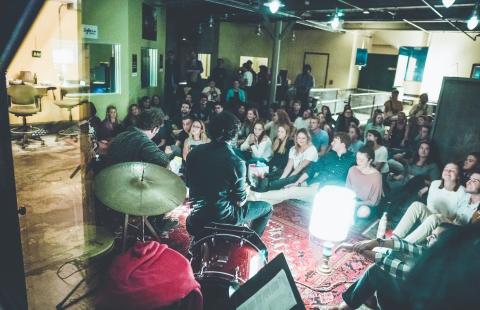What were the specific goals of this creative economy project? Describe the community development challenge or opportunity that your project was designed to address:
The space was originally designed to address issues of community access to music recording space, both for musicians but also for music producers and recording engineers who lacked access to a professional space to serve their clients. The concept for the project originated from the realization that no one needed to own a recording studio but a great number of people needed access to one. We wanted to create a space where anyone could walk in and record and that involves issues of cost, issues of cultural competence, flexible operating practices so folks can work however they like to work.
Music makers in our community have a very difficult time accessing space to create. On top of Boston’s general space crisis and the real estate pressure that is shuttering music spaces every month, leasing/renovating/operating real estate is not a music maker’s primary goal, and it certainly isn’t their core competency. We find this is true with small organizations as well. We are the space operators for the benefit of any individual or organization who needs it.
If the goals change over time, please describe how:
The biggest adjustment over the years was from an age-based access model to a universal access model. Originally we had programming for specific age groups, a teen program, and we ultimately found that the most authentic and effective programming we could offer was a more hands off, “let the community use the space however they want”, approach. We also had educational workshops for some time. We ultimately cut those in favor of making more studio time, and thereby more experiential learning opportunities available to our users.
In recent planning processes we tested a number of assumptions and were surprised about some of the answers. For example, as we considered expansion of our space, we assumed that music performance space was a high priority for our community. We learned that rehearsal was a greater need and priority and as result our expansion strategy pivoted to focus on music rehearsal space.
Who was involved in this project and what did they do? (be sure to include the partners from outside of the creative sector and how local voices were included):
The start of the space was a very bootstrapped, hands on process. It was essentially myself, a co-founder, a soldering iron and our credit cards. I did the 501c3 paperwork on my living room floor and we begged and borrowed and scrapped together our first space. Today a team of 12 runs the space, and there have been countless volunteer contractors and staffers and donors that have helped get us to where we are today including a number of community foundations like The Boston Foundation and, more recently, the Barr and Klarman Family Foundations.
The truth is our earliest partners were our users...music makers in the community. We operated (unsustainably) on about 90% earned revenue for the first three years. We relied entirely on fee for service. As we worked to beef up our staff and our capacity we had to learn to fundraise to cover the gaps without passing the increase cost on to our users. Today we operate on 25% earned revenue, but our expansion will have use moving back to 75% earned revenue over the next 3 years.
How does this project relate to a larger community development strategy?
There are some community development initiatives outside of our organization that our work fits into, like Mayor Walsh’s small business economic develop plan as well as the Boston Creates Cultural Plan.
There’s an interesting tension with music workspace, specifically recording space, because affordable technology has now made it possible to recording and create music very successfully in almost any technical environment: a bedroom, a classroom, a living room, a recording studio, a plane...you name it. For us it’s about the importance of getting together with other humans in an intentional space to make a thing. You can pray at home, but you go to church. (Or perhaps closer to home: you can drink at home but you to to a bar!) Why? To commune with other people, to participate in a greater human experience. Music making is the same...under the best conditions the outcome is greater than the sum of its parts. The psychological benefit of leaving home and going to work can’t be understated.
Our larger community development strategy is empathy through making something with other people. Getting together in person and looking them in the eye and participating in the intimate and vulnerable process of making music together. We can’t tell you exactly what the outcome of universal creative expression through music is, but we are committed to finding out.
Creating a physical community space to encourage that culture of making together to develop is our current tactic. Future tactics include professional development programming for those with the least access, community events designed to invite users with a variety of experiences to get to get together and know one another, and programming partnerships with organizations across neighborhoods, likely related to operating music making space within their existing facilities, to improve the accessibility and connectivity of community music workspace.
What projects or places, if any, inspired your approach to this creative economy project?
We didn’t look at any other projects specifically in the beginning, but we since have found a number that inspire us:
AS220 in Providence
The Center for New Music in San Francisco
Music City San Francisco
Ft. Knox and 2112 in Chicago
Women’s Audio Mission in San Francisco
